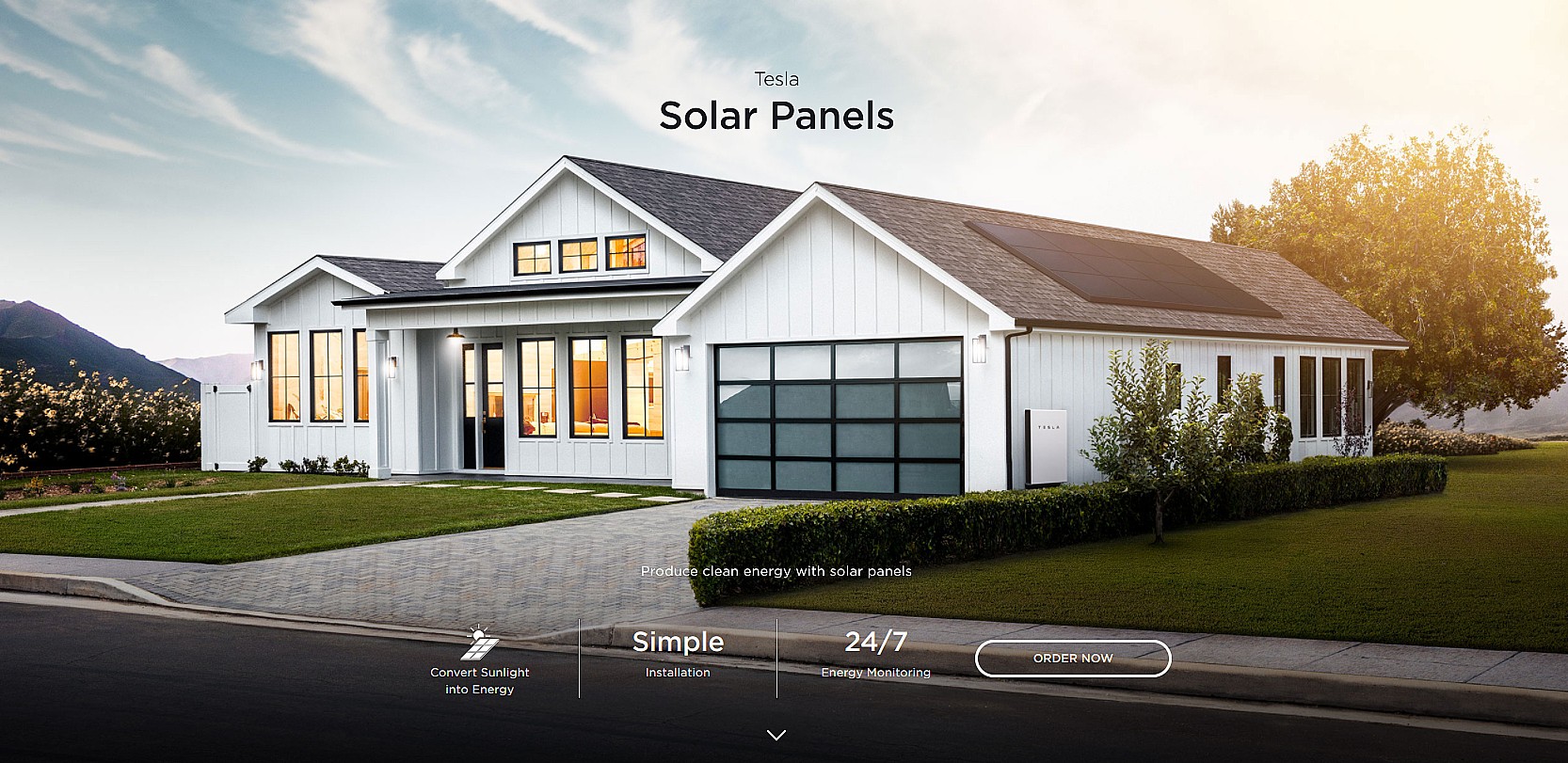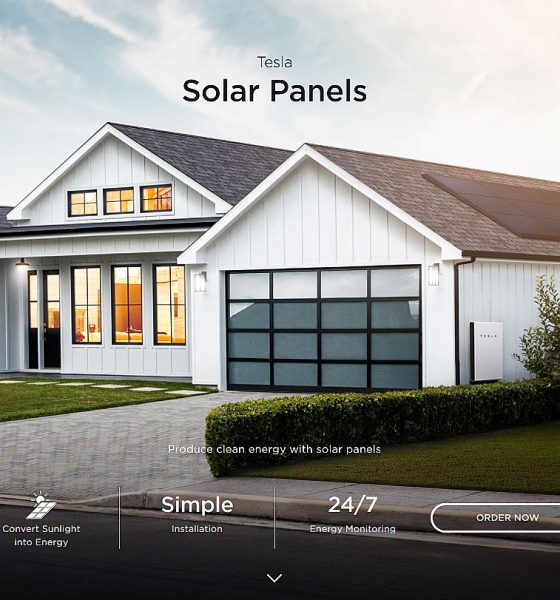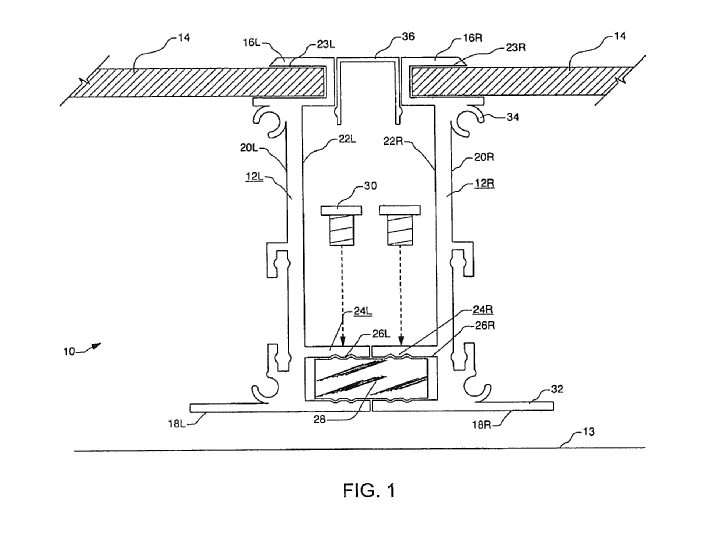

News
Tesla patent reveals Solar module aimed at faster, more attractive installations
Tesla Solar may have taken a step back from the limelight in recent years due to the electric car maker’s efforts to ramp the Model 3 sedan, but recent signs from the company indicate that it is now ready to start aggressively pushing its Energy business. Apart from high-profile projects such as the 50% expansion of the Hornsdale Power Reserve, Tesla also appears to be working on notable improvements to its residential solar system installation processes.
One such improvement was outlined in a recent patent application titled Method and apparatus for mounting photovoltaic modules. The patent describes a novel mounting system for photovoltaic modules that make them easier to install, maintain, and even remove if necessary. Tesla notes that its patent allows solar panel installations to be more aesthetically pleasing than traditional PV setups as well.
In its discussion, Tesla explained that solar panel installations are usually hit by a number of challenges, particularly in terms of alignment, grounding, wiring, rafter connections, and several other factors related to the mounting of the PV system itself. With this in mind, Tesla stated that there is a clear need for a PV module mounting system that is simple, cost-effective, and widely adaptable.

To address these challenges, Tesla has come up with an invention that utilizes an interlocking photovoltaic module mounting system. This design provides a “one piece, integrated photovoltaic module frame portion that is directly mountable to a support structure and interlocks with separate adjoining photovoltaic module frame portions.”
“A preferred embodiment of the invention includes an interlocking mechanism comprising at least one C-shaped channel portion on the outside surface of the PV module frame member with the opening oriented parallel to the plane of the substantially flat top solar cell covering, and which interlocks with an identical adjoining C-shaped channel portion of an adjoining PV module frame member through the use of a separate male coupling member which is inserted into the C-shaped portions of the two adjoining modules. The adjacent C-shaped channel portions do not overlap each other. The male coupling member may also serve as a means for providing electric ground continuity between PV modules,” Tesla wrote.
Such a system would offer a variety of benefits for Tesla and homeowners. Among these benefits include potentially faster installation processes, easier maintenance, and even simpler removal, to name a few. Utilizing the design outlined in Tesla’s patent, the electric car maker further explained that solar installations would look better, since the mounting systems provide no gaps between modules. Such a system will likely not make regular solar panel installations as attractive as, say, a Tesla Solar Roof installation, but it does allow for a very sleek overall look.
“The inventive system thus provides an interlocking, self-grounding, and self-aligning framing structure for each module, which provides three-dimensional adjustability, allows simple connection to the rafters, minimizes penetrations in the roof, allows access to wiring interconnects without removing modules, does not require expensive strut hardware, utilizes a non-overlapping, interlocking mechanism which allows for all PV modules in an array to rest in the same plane instead of having consecutive modules at slightly different angles due to the overlapping nature of an interleaved connection, and which in some embodiments allows removal of single PV modules from the middle of the array.
“The inventive system also provides an attractive appearance by having a low profile, with no gaps between modules, and no visible hold-downs or hardware, plus optional cosmetic flashings for screening visible edges of the array and optional cosmetic caps for covering the small gaps that may occur, or in one embodiment, for bridging between two adjacent PV modules to cover the wiring. Additional benefits are further described herein,” Tesla noted.
Promoting solar installations to homeowners is a key component of Tesla Energy’s business. And to gain an advantage in the residential solar market, Tesla would need to ensure that its PV installations are worthy of its premium brand while being cost-effective overall. Tesla’s electric cars are a cut above the rest of the market and thus, the expectations for its energy business are high. With such ideas as presented in this recently published patent application, it would appear that Tesla is actively exploring ways to improve its residential solar initiatives, even down to their mounting system.
Read the full discussion on Tesla’s innovative PV mounting solution patent here.

News
Tesla FSD fleet is nearing 7 billion total miles, including 2.5 billion city miles
As can be seen on Tesla’s official FSD webpage, vehicles equipped with the system have now navigated over 6.99 billion miles.

Tesla’s Full Self-Driving (Supervised) fleet is closing in on almost 7 billion total miles driven, as per data posted by the company on its official FSD webpage.
These figures hint at the massive scale of data fueling Tesla’s rapid FSD improvements, which have been quite notable as of late.
FSD mileage milestones
As can be seen on Tesla’s official FSD webpage, vehicles equipped with the system have now navigated over 6.99 billion miles. Tesla owner and avid FSD tester Whole Mars Catalog also shared a screenshot indicating that from the nearly 7 billion miles traveled by the FSD fleet, more than 2.5 billion miles were driven inside cities.
City miles are particularly valuable for complex urban scenarios like unprotected turns, pedestrian interactions, and traffic lights. This is also the difference-maker for FSD, as only complex solutions, such as Waymo’s self-driving taxis, operate similarly on inner-city streets. And even then, incidents such as the San Francisco blackouts have proven challenging for sensor-rich vehicles like Waymos.
Tesla’s data edge
Tesla has a number of advantages in the autonomous vehicle sector, one of which is the size of its fleet and the number of vehicles training FSD on real-world roads. Tesla’s nearly 7 billion FSD miles then allow the company to roll out updates that make its vehicles behave like they are being driven by experienced drivers, even if they are operating on their own.
So notable are Tesla’s improvements to FSD that NVIDIA Director of Robotics Jim Fan, after experiencing FSD v14, noted that the system is the first AI that passes what he described as a “Physical Turing Test.”
“Despite knowing exactly how robot learning works, I still find it magical watching the steering wheel turn by itself. First it feels surreal, next it becomes routine. Then, like the smartphone, taking it away actively hurts. This is how humanity gets rewired and glued to god-like technologies,” Fan wrote in a post on X.
News
Tesla starts showing how FSD will change lives in Europe
Local officials tested the system on narrow country roads and were impressed by FSD’s smooth, human-like driving, with some calling the service a game-changer for everyday life in areas that are far from urban centers.

Tesla has launched Europe’s first public shuttle service using Full Self-Driving (Supervised) in the rural Eifelkreis Bitburg-Prüm region of Germany, demonstrating how the technology can restore independence and mobility for people who struggle with limited transport options.
Local officials tested the system on narrow country roads and were impressed by FSD’s smooth, human-like driving, with some calling the service a game-changer for everyday life in areas that are far from urban centers.
Officials see real impact on rural residents
Arzfeld Mayor Johannes Kuhl and District Administrator Andreas Kruppert personally tested the Tesla shuttle service. This allowed them to see just how well FSD navigated winding lanes and rural roads confidently. Kruppert said, “Autonomous driving sounds like science fiction to many, but we simply see here that it works totally well in rural regions too.” Kuhl, for his part, also noted that FSD “feels like a very experienced driver.”
The pilot complements the area’s “Citizen Bus” program, which provides on-demand rides for elderly residents who can no longer drive themselves. Tesla Europe shared a video of a demonstration of the service, highlighting how FSD gives people their freedom back, even in places where public transport is not as prevalent.
What the Ministry for Economic Affairs and Transport says
Rhineland-Palatinate’s Minister Daniela Schmitt supported the project, praising the collaboration that made this “first of its kind in Europe” possible. As per the ministry, the rural rollout for the service shows FSD’s potential beyond major cities, and it delivers tangible benefits like grocery runs, doctor visits, and social connections for isolated residents.
“Reliable and flexible mobility is especially vital in rural areas. With the launch of a shuttle service using self-driving vehicles (FSD supervised) by Tesla in the Eifelkreis Bitburg-Prüm, an innovative pilot project is now getting underway that complements local community bus services. It is the first project of its kind in Europe.
“The result is a real gain for rural mobility: greater accessibility, more flexibility and tangible benefits for everyday life. A strong signal for innovation, cooperation and future-oriented mobility beyond urban centers,” the ministry wrote in a LinkedIn post.
News
Tesla China quietly posts Robotaxi-related job listing
Tesla China is currently seeking a Low Voltage Electrical Engineer to work on circuit board design for the company’s autonomous vehicles.

Tesla has posted a new job listing in Shanghai explicitly tied to its Robotaxi program, fueling speculation that the company is preparing to launch its dedicated autonomous ride-hailing service in China.
As noted in the listing, Tesla China is currently seeking a Low Voltage Electrical Engineer to work on circuit board design for the company’s autonomous vehicles.
Robotaxi-specific role
The listing, which was shared on social media platform X by industry watcher @tslaming, suggested that Tesla China is looking to fill the role urgently. The job listing itself specifically mentions that the person hired for the role will be working on the Low Voltage Hardware team, which would design the circuit boards that would serve as the nervous system of the Robotaxi.
Key tasks for the role, as indicated in the job listing, include collaboration with PCB layout, firmware, mechanical, program management, and validation teams, among other responsibilities. The role is based in Shanghai.
China Robotaxi launch
China represents a massive potential market for robotaxis, with its dense urban centers and supportive policies in select cities. Tesla has limited permission to roll out FSD in the country, though despite this, its vehicles have been hailed as among the best in the market when it comes to autonomous features. So far, at least, it appears that China supports Tesla’s FSD and Robotaxi rollout.
This was hinted at in November, when Tesla brought the Cybercab to the 8th China International Import Expo (CIIE) in Shanghai, marking the first time that the autonomous two-seater was brought to the Asia-Pacific region. The vehicle, despite not having a release date in China, received a significant amount of interest among the event’s attendees.








